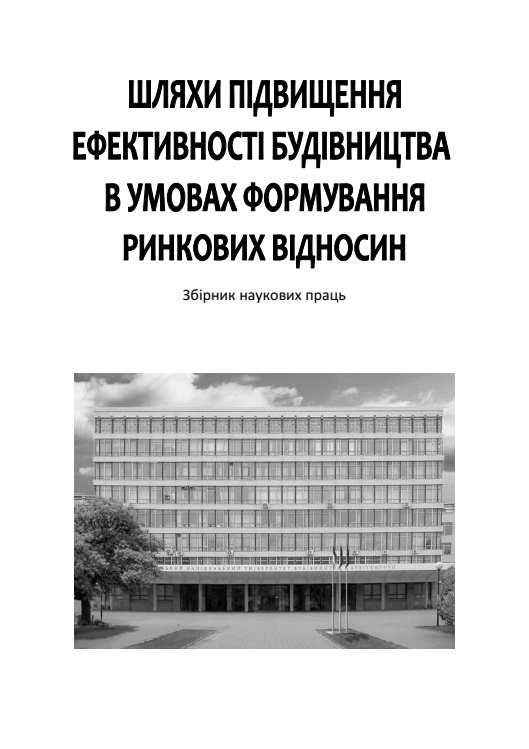Assessment of the attractiveness of construction technologies in conditions of socio-environmental limitations
DOI:
https://doi.org/10.32347/2707-501x.2018.38.215-220Keywords:
ecological and economic constraints, recycling, greening, development, circular production model, sustainable developmentAbstract
The article considers the variant indicators of the assessment of production (in particular, construction) technologies used for the production of products on the principles of sustainable development. The greening of the construction industry, aimed at minimizing the use of natural resources, must proceed by replacing the existing linear production model with a circular economic model as the most appropriate resource-saving requirement.
Ways of introduction of the strategy of ecological construction for the construction industry of Ukraine are proposed while involving in the process of new construction and modernization by the development companies the mechanisms of recycling of building structures, products and materials.
References
THE 17 GOALS. The Global Goals for sustainable development. URL: https://www.globalgoals.org/.
Орловська Ю. В., Яковишина Т. Ф., Орловський Є. С. Зелене будівництво як складова політики ЄС щодо розвитку циркулярної економіки. Східна Європа: економіка, бізнес та управління. Електронний журнал. 2014. Вип. 5(05). С. 365 –371. URL: http://www.easterneurope-ebm.in.ua/journal/5_2016/70.pdf.
НАЦОНАЛЬНА СТРАТЕГІЯ управління відходами в Україні до 2030 року, 2017. (Розпорядження КМУ №820-р. від 8.11.2017 р.) Офіційний сайт КМ України URL: https://zakon.rada.gov.ua/laws/show/820-2017-%D1%80.
Кизима Р.А., Єгоркіна Л.А., Веремеєнко С.І., Доманський Г.В., Яковчук В.В. Екологія в будівництві. Харків: Бурун Книга, 2007. 224 с.
Шпакова Г.В. Шляхи і можливість переробки будівельних відходів в Україні // Будівельне виробництво. – Київ, 2012. – Вип. №54. – С. 22-25.
Оцінка рівня ефективності використання виробничих ресурсів, як засіб попередження банкрутства у будівництві / Крикун К.В., Оліферук С.Л., Рязанов А.С. // Містобудування та територіальне планування. 2014. Вип. 50. С. 168‒170.
Техніко-економічній аналіз і оцінка рівня витрат виробничих ресурсів на забезпечення якості у будівництві / К.В. Крикун, А.С. Рязанов, С.Л. Оліферук // Містобудування та територіальне планування. 2013. Вип. 48. С. 175‒178
Вахович І.В., Терещенко Л.В., Цифра Т.Ю., Редькін Ю.О., Шпакова Г.В. Економічна ефективність використання вторинних ресурсів в будівництві // Шляхи підвищення ефективності будівництва в умовах формування ринкових відносин. Вип. 28. Частина 2. – К.: Міносвіти України, КНУБА, 2012. – С. 125‒131.
Рамкова директива ЄС про відходи [Електронний ресурс]: Директива Європарламенту і Ради 2006/12/ЄС від 5 квітня 2006 р. про відходи. – Режим доступу: http://www.uecr.gov. ua/ua/int_documents/Ramkova-direktiva-S-provdhodi-Direktiva-vroparlamentu-Radi-200612Svd-5-kvtnya-2006-r-pro-vdhodi.htm.
Удосконалення системи управління відходами в Україні в контексті європейського досвіду / В. С. Міщенко, Г. П. Виговська, Ю. М. Маковецька та ін. – К.: Лазуріт-Поліграф, 2012. – 120 с.
Downloads
How to Cite
Issue
Section
License
Copyright (c) 2020 H. V. Shpakova

This work is licensed under a Creative Commons Attribution 4.0 International License.
Authors who publish with this journal agree to the following terms:
- Authors retain copyright and grant the journal right of first publication with the work simultaneously licensed under a Creative Commons Attribution License that allows others to share the work with an acknowledgement of the work's authorship and initial publication in this journal.
- Authors are able to enter into separate, additional contractual arrangements for the non-exclusive distribution of the journal's published version of the work (e.g., post it to an institutional repository or publish it in a book), with an acknowledgement of its initial publication in this journal.
- Authors are permitted and encouraged to post their work online (e.g., in institutional repositories or on their website) prior to and during the submission process, as it can lead to productive exchanges, as well as earlier and greater citation of published work (See The Effect of Open Access).

